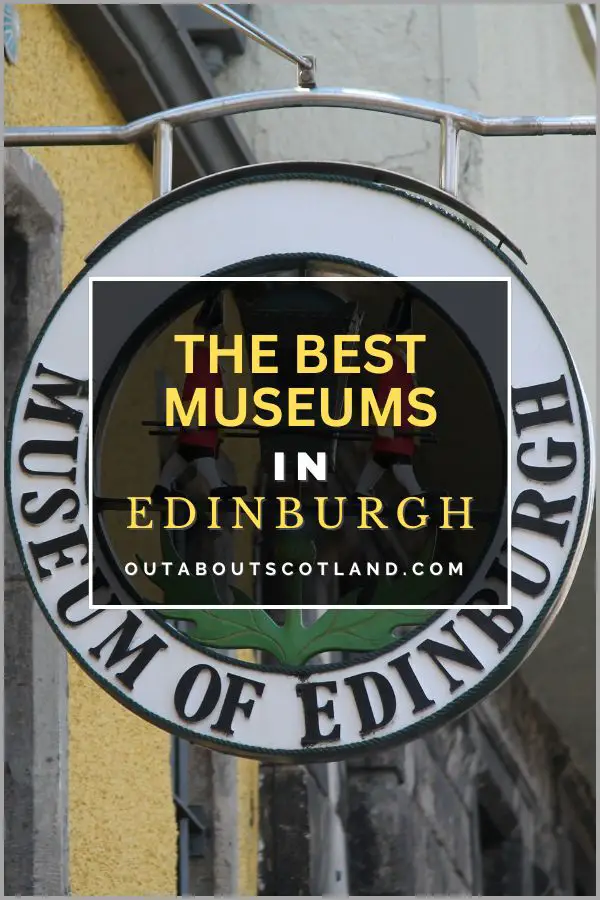As Scotland’s most-visited city, Edinburgh is understandably full of attractions. From Edinburgh Castle to Holyrood Palace, there are countless things to see and do, although many activities tend to be geared towards families with children. That being said, there are lots of tourist attractions that are equally interesting for adults, whether they’re lone travellers or retired couples.
In this article, you’ll discover a collection of highly-rated things to do in Edinburgh for adults that are guaranteed to offer all visitors a great experience, from supping a wee dram of whisky on the Royal Mile to browsing priceless artworks in the national gallery.
There are also a few off-the-beaten-path attractions that will let you avoid the city’s throngs of tourists, as well as some recommendations for taking a guided tour if you’d prefer to have a local show you around.
The Scotch Whisky Experience
Address: 354 Castlehill, Edinburgh, EH1 2NE
Contact details: Tel. 0131 220 0441
Out About Scotland guide: The Scotch Whisky Experience
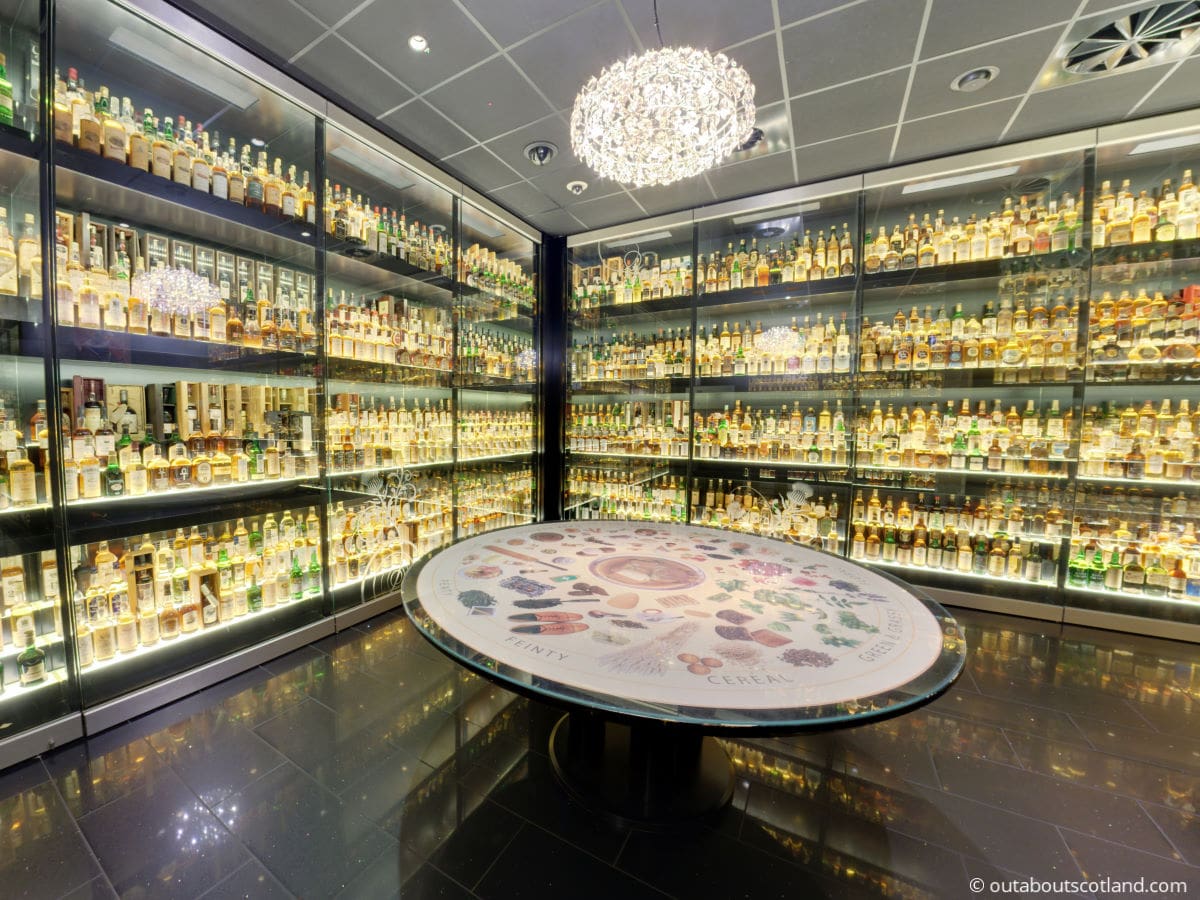
If you’re on a visit to Edinburgh, your trip won’t be complete without a visit to the Scotch Whisky Experience, located just a short walk from Edinburgh Castle Esplanade on the Royal Mile. The attraction features tours and whisky-tasting sessions, along with a very enjoyable journey through the history of one of Scotland’s most famous exports, brought to you by several resident ghostly tour guides.
At the beginning of the tour, you sit inside a whisky barrel, which transports you back in time while taking you on a journey through a replica distillery. The ghosts of the old distillery tell the tale of the distilling process, and at the conclusion, a real tour guide treats you to a whisky tasting.
These guides are whisky experts, and they’ll be only too happy to explain the history of whisky production, from its earliest days to the multi-billion-pound industry that it is today.
The high point of any of the tours has to be the whisky collection, which has the record of being the world’s largest, housing an incredible 3,384 bottles. The collection took over 35 years to build and is open for viewing in a room full of enormous glass display cases.
The Scotch Whisky Experience also features a superb whisky gift shop, a café, and a restaurant.
If you love whisky, I recommend joining the Scotch Malt Whisky Society. Become a member for exclusive access to the world’s biggest selection of single-cask whisky.
The Balmoral Hotel
Address: 1 Princes Street, Edinburgh, EH2 2EQ,
Contact details: Tel. 0131 556 2414
Out About Scotland guide: The Balmoral Hotel

The Balmoral Hotel on Princes Street is one of the city’s most iconic buildings, and while it’s not exactly a tourist attraction in the truest sense, it’s more than worth visiting if you want to experience the finest dining in Edinburgh in beautiful surroundings that are steeped in history.
The hotel was built in 1902 by the North British Railway Company as a way to service the ever-increasing numbers of travelling business people that were arriving in Edinburgh via Waverley Station.
Over the years, it changed hands several times, but for the past three decades, Rocco Forte has owned and operated it, and has completely renovated it into a shining example of Scottish luxury.
Inside, visitors can relax in six different dining areas that all offer a slightly different experience. Brasserie Prince, for example, is a French-themed bistro that is relaxed and informal, while Palm Court is set in an extravagant hall that’s flooded with natural light from a giant glass dome ceiling.
One area I have to recommend for an evening visit is The Balmoral Hotel’s Scotch bar, which features one of the largest collections of single malt whisky in Edinburgh, with over five hundred different bottles to sample at any time.
It’s not a large bar by any means, but the atmosphere is warm and cosy, and the staff are incredibly enthusiastic about whisky, so if you have any questions about ‘the water of life’, they’ll be more than happy to answer them.
Dean Village
Address: Dean Path, Edinburgh, EH4 3AY
Contact details: NA
Out About Scotland guide: Dean Village
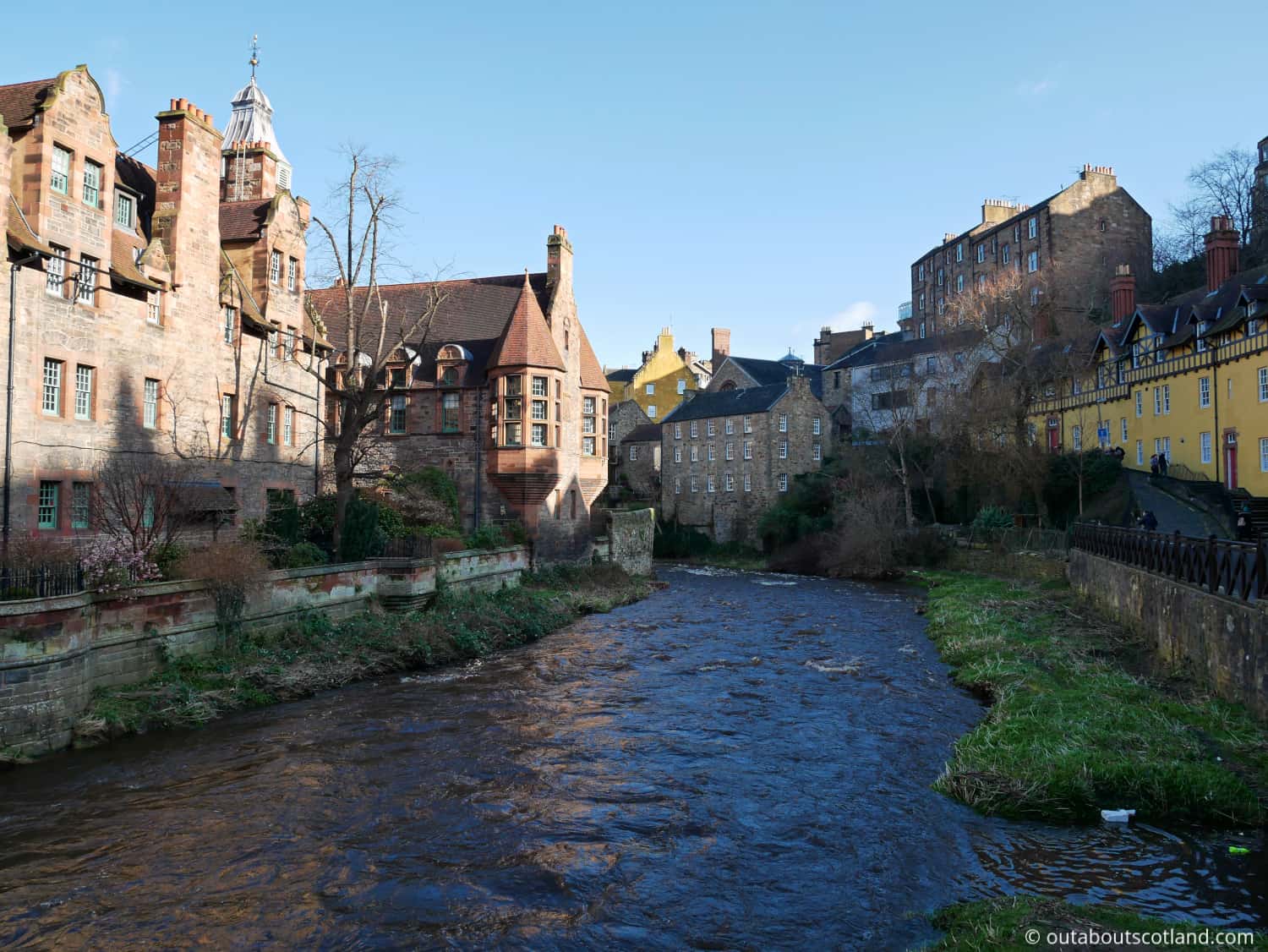
Once the location of an 800-year-old grain milling industry, Dean Village is now best known for its beautiful architecture, which features in so many iconic photos of Edinburgh.
During its heyday, Dean Village centred around several mills on the Water of Leith that refined wheat crops transported in from the Lothians. There were eleven working mills in total in this one small area of Edinburgh, along with buildings to house hundreds of mill workers, all of which were major contributors to the city’s economy.
However, due to advances in engineering, the old mills went into a slow decline in the 19th century, and the village fell into near ruin for well over a hundred years until a programme of regeneration began in the 1970s.
Today, Dean Village is one of the most sought-after residential areas in Edinburgh, and the village has become a popular tourist attraction thanks to its picturesque setting on the Water of Leith.
A good route to follow when walking through the village is to admire the stunning architecture of Wells Court and then continue down under Thomas Telford’s imposing Dean Bridge. From there, you can either follow the path onwards to Stockbridge with its vibrant cafés and bars or take a short walk to the Modern Art Galleries on Belford Road.
The Grassmarket
Address: Old Town, Edinburgh, EH1 2HS
Contact details: NA
Out About Scotland guide: The Grassmarket
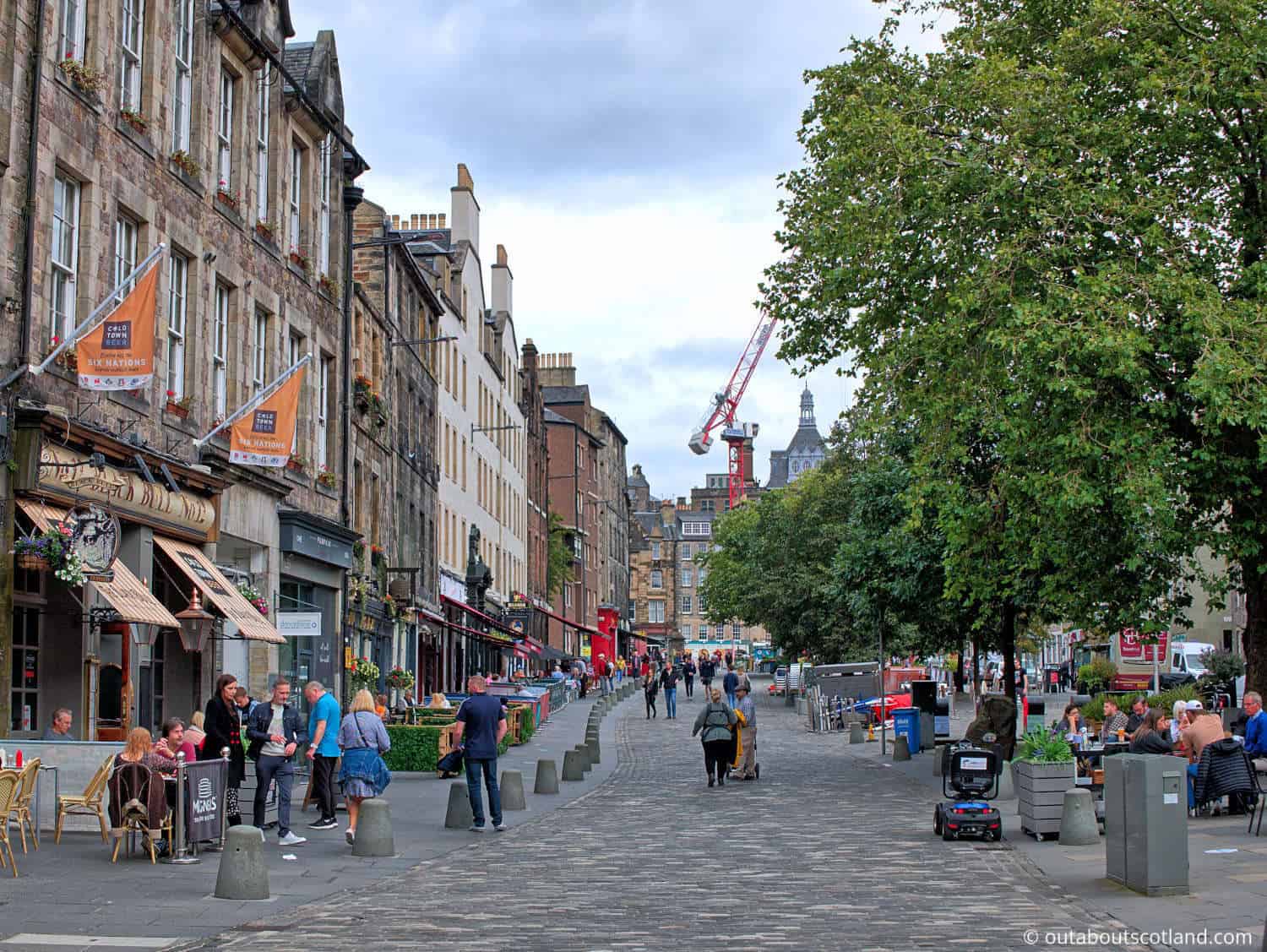
The Grassmarket is a bustling collection of pubs and restaurants around a large open square at the southern edge of Edinburgh Castle. Because the district is so centrally located within the city, you can easily find it by either walking west from the Cowgate or walking south from Castle Esplanade.
The Grassmarket is full of Scottish architecture from the 17th century, and many of the high-rise tenement buildings that Edinburgh is famous for are still in use as private residences.
It really is a beautiful part of the city, especially on nearby Victoria Street, which is famous for the colourful shopfronts that slope up to the George IV Bridge. Heading back down to the Grassmarket, you might be surprised to see that the area is so spacious considering the rest of the Old Town is so compact and built-up.
The reason for this lies in the original purpose for which the area was used, namely as a place to sell horses and cattle—hence the name ‘Grassmarket’, which derives from the time when grass was kept in the square to feed the animals.
This part of Edinburgh has been popular with tourists for a number of years due to the assortment of pubs that line the streets, and it’s still enjoyed today with outside seating areas for several restaurants and bars.
Greyfriars Kirk
Address: 1 Greyfriars, Edinburgh, EH1 2QQ
Contact details: Tel. 0131 225 1900
Out About Scotland guide: Greyfriars Kirk
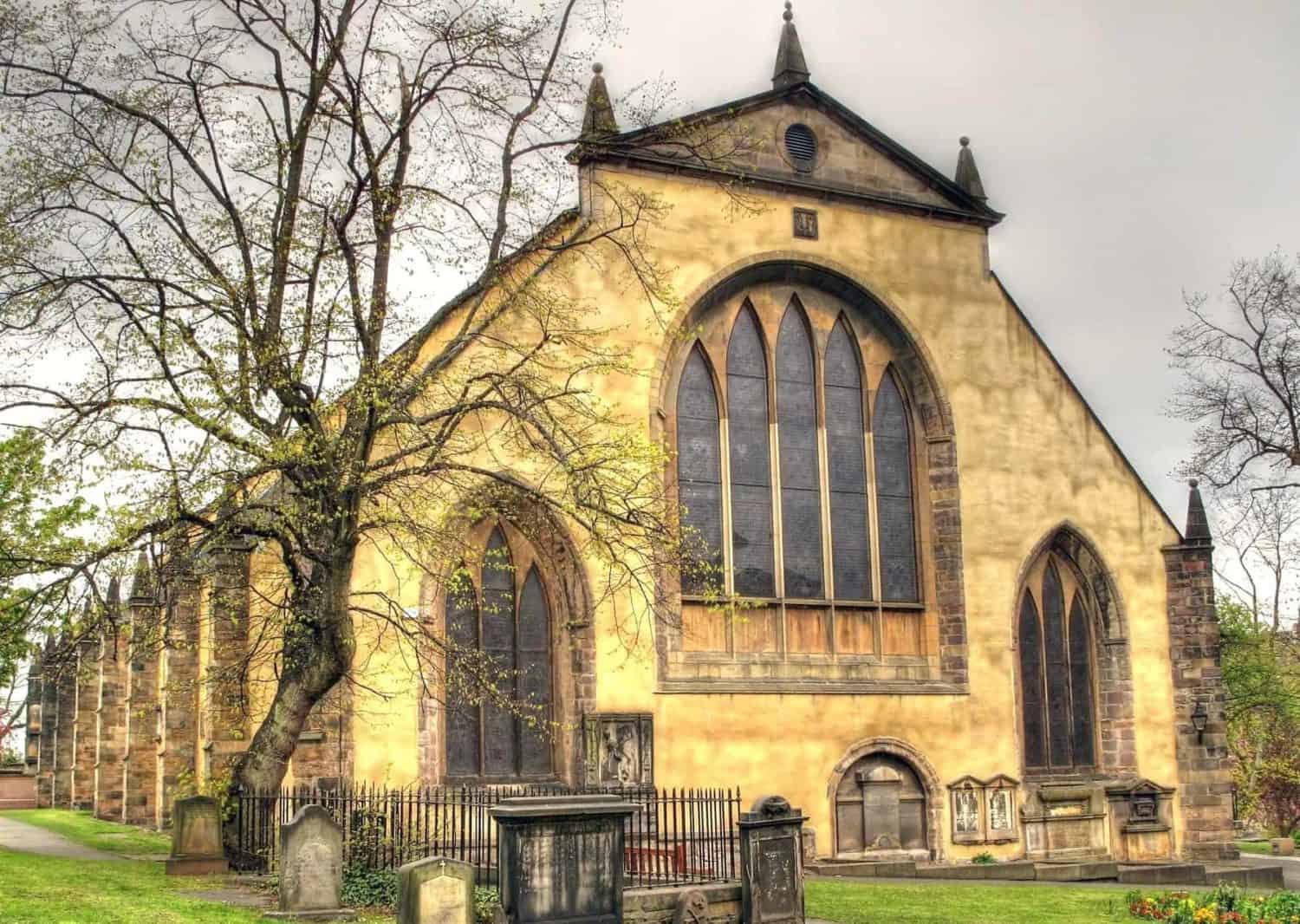
Greyfriars Kirk sits in a prime location opposite the tower entrance of the National Museum of Scotland and close to Candlemaker Row, the winding street that leads onto the Grassmarket. The kirk is still very much in use as a parish church as well as being a tourist hotspot for visitors keen to visit the wee Highland Terrier, Bobby.
The story of Greyfriars extends back through many centuries, and the old kirk is full of history as it’s one of the oldest surviving buildings outside of Edinburgh’s Old Town.
There’s a small museum on the site that tells the story of the religious history of Greyfriars from the time of the Franciscan monks to the present day, and it includes one of only a handful of the original copies of the National Covenant that was signed in the Kirk in 1638.
Visitors are free to walk around the outside of the kirk at any time and can explore the inside at times when there are no services or events happening. The kirkyard that surrounds the church is managed by a separate trust that looks after the huge number of tombstones, monuments, and vaults that are crowded into the site.
Leith
Address: Leith, Edinburgh, EH6
Contact details: NA
Out About Scotland guide: Leith
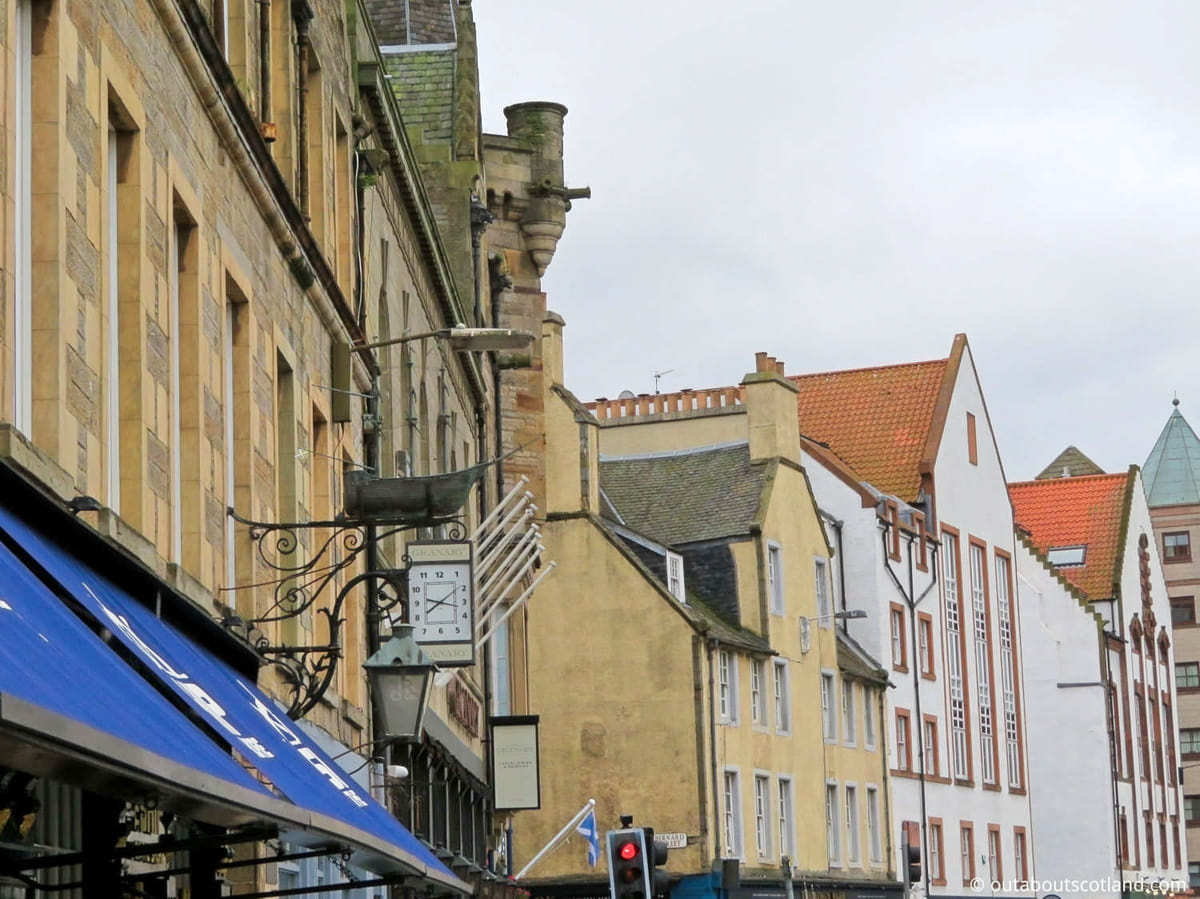
The main shipping port at Leith was instrumental in the development of Scotland as an important trading partner with Europe, though today it’s more of a tourist destination than an industrial complex. Although the industrialised areas of the port are still in use, with the extensive dockyard still receiving ships from all over the world, Leith is nowadays recognised for its trendy pubs, bars, and restaurants.
After a long period of neglect, Leith was extensively redeveloped in the 1970s, and it’s now regarded as one of the premier hipster hotspots in Edinburgh thanks to a significant programme of regeneration over the last twenty years.
Highlights in Leith are the Ocean Terminal shopping centre with its wide variety of shops and restaurants and the Royal Yacht Britannia that’s permanently moored alongside. Further inland is the Leith Farmers Market, which is held every Saturday and has become a foodie mecca with sumptuous homemade food made by local small businesses.
Other attractions include Leith Late, an annual multi-arts festival held in June when some of the country’s best up-and-coming artists get to showcase their works to the general public. There are also Michelin-starred restaurants like The Kitchin and Restaurant Martin Wishart, which serve top-class food in historic 17th-century buildings.
As a top tip, if you’d like to enjoy a good walk after you’ve explored Leith, follow the path along the Water of Leith for 1.5 miles to Canonmills, after which you can head to the lovely Royal Botanic Gardens in Edinburgh.
The Scottish National Gallery
Address: The Mound, Edinburgh, EH2 2EL
Contact details: Tel. 0131 624 6200
Out About Scotland guide: The Scottish National Gallery
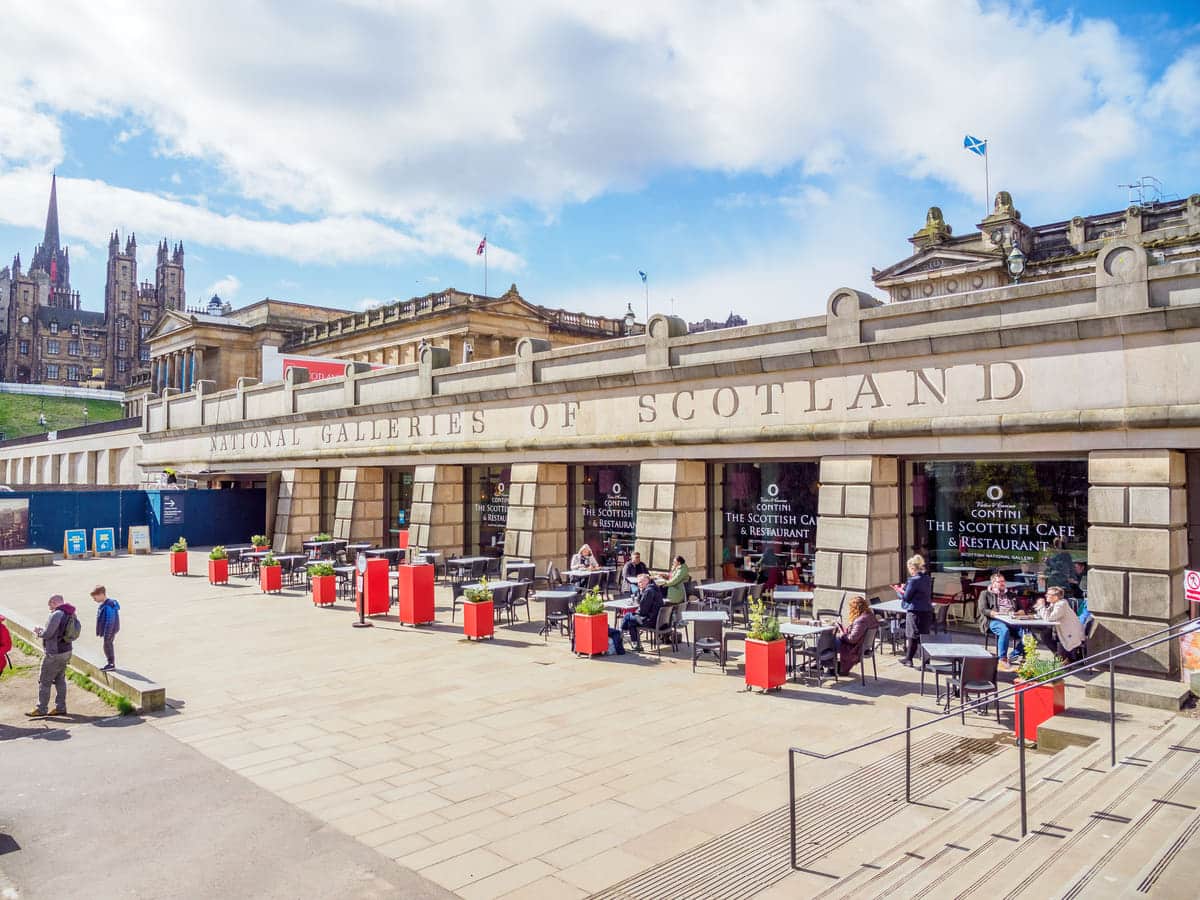
The enormous neo-classical Scottish National Gallery and the Royal Scottish Academy (RSA) building behind it cannot fail to impress visitors to Edinburgh. These galleries display some of the most significant art collections in the world, including masterpieces by Rembrandt, Vermeer, Constable, Turner, Monet, and Van Gogh.
However, the largest part of the collection covers the entire history of Scottish paintings, including works by Ramsay, Raeburn, Wilkie, and McTaggart.
The famous architect William Playfair created the current Scottish National Gallery to house the RSA’s national art collection, and it did so until 1912, when the RSA moved into its present location. After extensive remodelling, the Scottish National Gallery re-opened with an emphasis on Scottish and European art, a theme that continues to this day.
There’s also a newly redesigned underground section that’s particularly popular with tourists, as it houses a restaurant and café as well as a shop that offers copies of some of the artwork from both galleries.
The entrance to the underground area is located at the same level as Princes Street Gardens, so it’s a great place to visit for a bite to eat after exploring the gardens or the galleries on the upper level.
The Scottish National Gallery of Modern Art
Address: 75 Belford Road, Edinburgh, EH4 3DR
Contact details: Tel. 0131 624 6200
Out About Scotland guide: The Scottish National Gallery of Modern Art
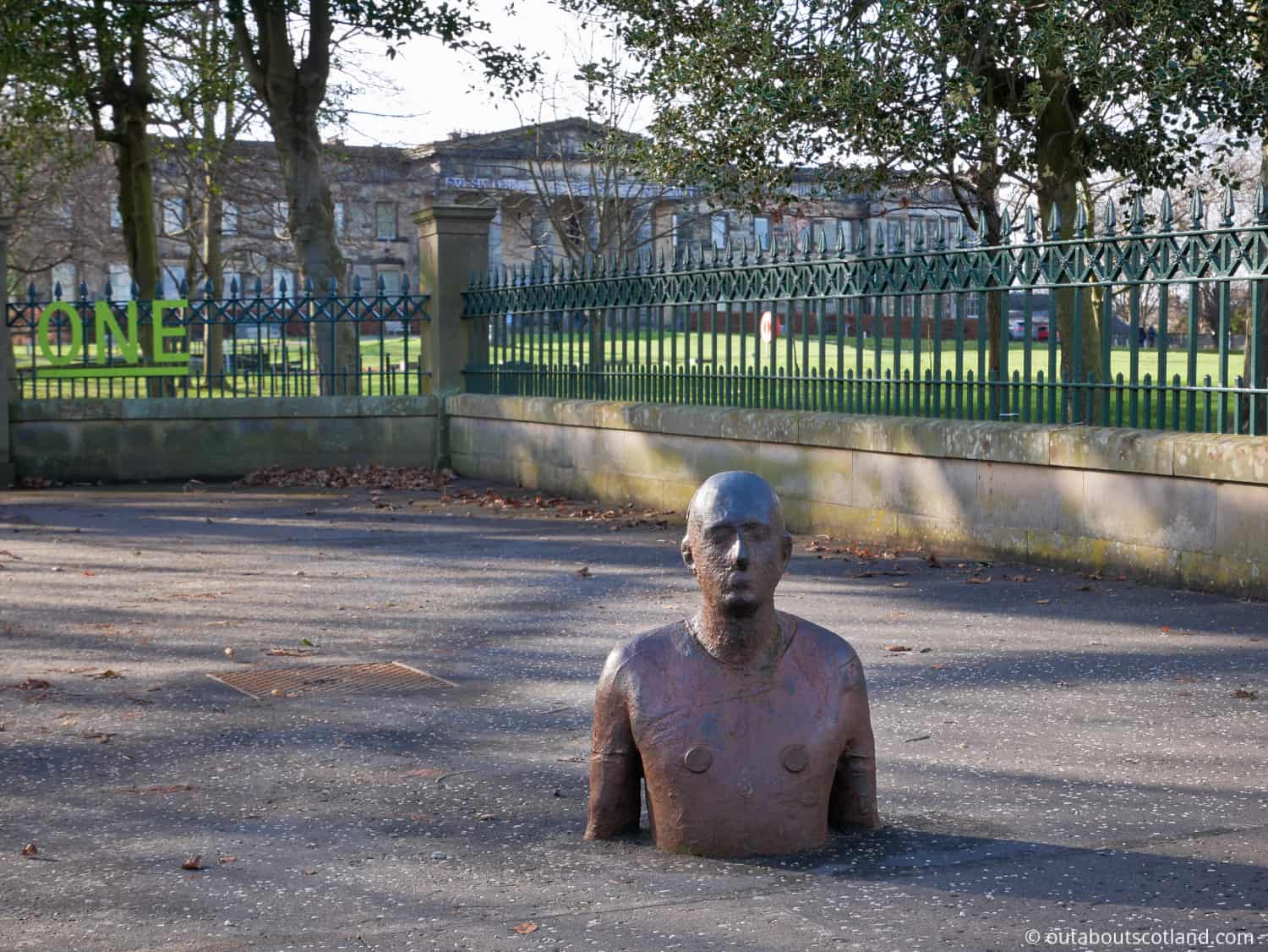
The primary purpose of the National Gallery of Modern Art is to showcase the Scottish national collection of contemporary art dating from the early 20th century to the present day. This is the largest modern art collection in Scotland and covers all forms of media across 6,000 pieces, from paintings and videos to sculptures.
The galleries are divided into two separate buildings: the Modern One and the Modern Two. Modern One features a revolving exhibition of artworks from the permanent collection, which includes pieces from renowned artists like Francis Bacon, David Hockney, Tracey Emin, and Andy Warhol.
Across the road, Modern Two displays more artworks from the permanent collection as well as a continually updated catalogue of temporary exhibits and an exhibition on the history of modern art media.
Outside, a sculpture park created by the landscape designer Charles Jencks dominates the lawn of Modern One, where a huge serpentine mound surrounds a crescent-shaped pool of water along with several prized sculptures.
The gallery provides a bus service to transport visitors from the Scottish National Gallery in the city centre to the Modern Art Gallery and back again, while cafés can be found both in Modern One and Modern Two, along with souvenir shops, an art library, and a book archive.
The Scottish National Portrait Gallery
Address: 1 Queen Street, Edinburgh, EH2 1JD
Contact details: Tel. 0131 624 6200
Out About Scotland guide: Scottish National Portrait Gallery
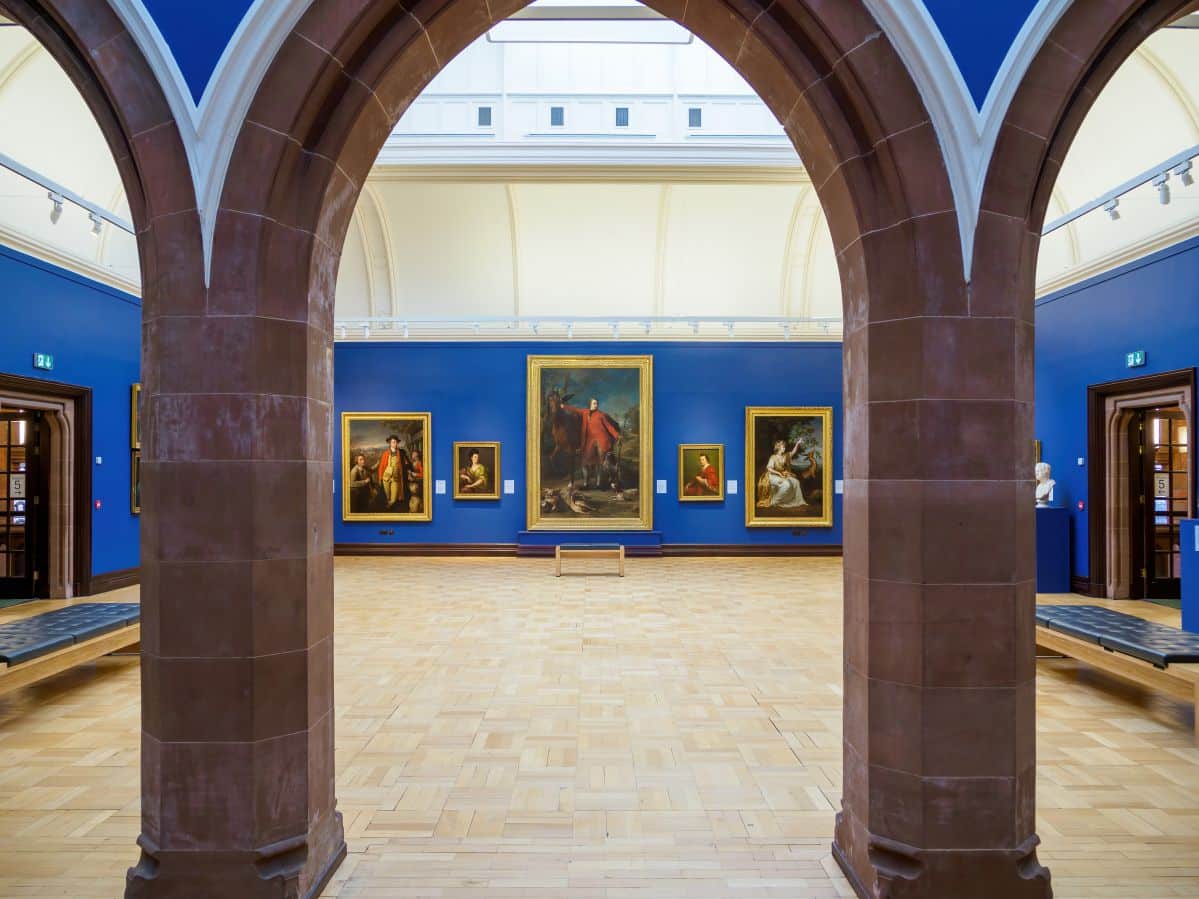
The Scottish National Portrait Gallery contains the national collection of portraits as well as the national photography collection, all of which are studies of famous Scots from various periods of history. In total, the collection boasts over 3,000 paintings and sculptures, 25,000 prints and drawings, and an incredible 38,000 photographs.
The building stretches out symmetrically on either side of the main hall, and the artworks are displayed over an expansive three floors in rooms that feature original decorations from the 1800s.
Among the collection are prominent figures from Scotland’s history that will be immediately recognisable, including Mary Queen of Scots and Bonnie Prince Charlie. Other historic figures include Flora MacDonald, Glaswegian designer Charles Rennie Mackintosh, and a large collection of Scots shown on canvas and photographic print.
The gallery publicly displays an impressive 850 works at any one time, and facilities for visitors include an education centre, shops, a café, and disabled access.
The Scottish Parliament Building
Address: Edinburgh, EH99 1SP
Contact details: Tel. 0131 348 5000
Out About Scotland guide: The Scottish Parliament Building

The Scottish Parliament building in Edinburgh is the home of the Scottish government and is a world-class example of modern architecture. Sitting at the bottom of The Royal Mile on four acres of land, the building is an unusual tourist attraction but it’s well worth taking a look inside, especially as it’s free to get in.
The location where the Parliament building is located seems to perfectly sum up Scotland, with the natural wonders of Holyrood Park to one side, the majestic Holyrood Palace on another, and the historic Royal Mile running past it and up towards the centre of the castle.
The building has been recognised with several international awards for its architecture, and visitors are welcome to explore it year-round.
On non-sitting days (usually Monday, Friday, and weekends), visitors can view the Main Hall and access the public galleries of the debating chamber and the main committee rooms. Guided tours are also available on non-sitting days, which allow visitors to access the garden lobby and committee rooms.
St. Giles Cathedral
Address: High St, Edinburgh, EH1 1RE
Contact details: Tel. 0131 226 0674
Out About Scotland guide: St. Giles Cathedral
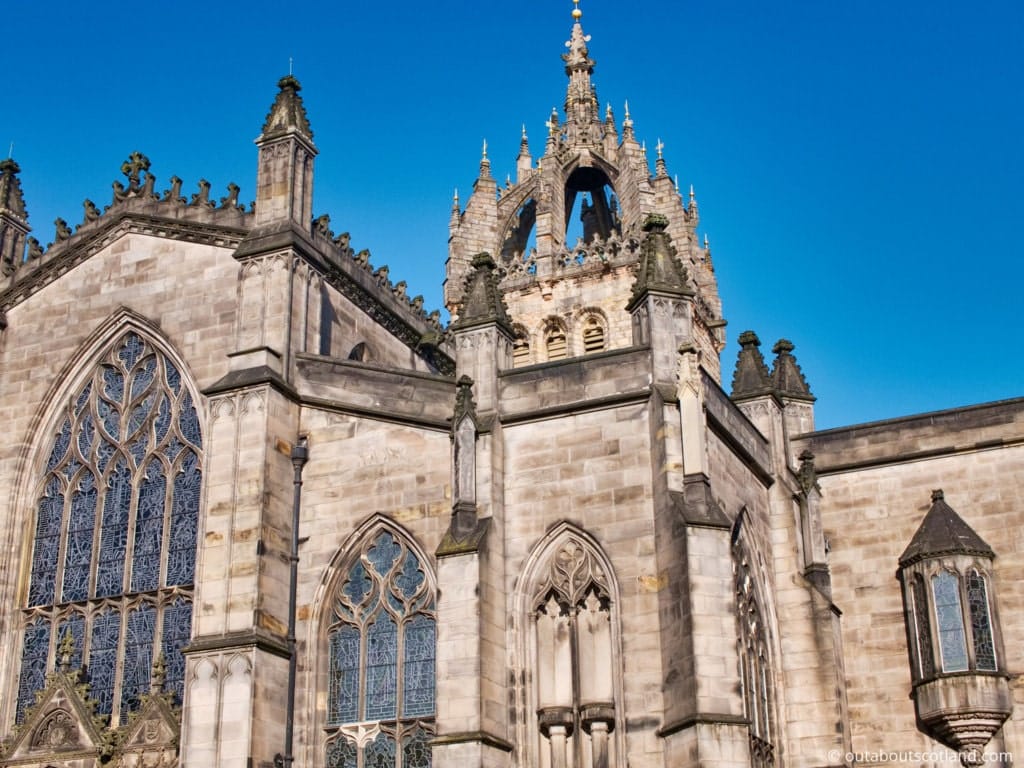
The distinctive 15th-century crown steeple of St. Giles Cathedral is one of the most-viewed features in Edinburgh and takes a place alongside Edinburgh Castle and Holyrood Palace as one of the most historically significant buildings in Scotland.
The church has been a focal point for religious activity in Edinburgh for over 900 years (although the building that we see today traces its roots back to the 14th century), and due to its central location on the Royal Mile, it’s a popular tourist attraction today.
The church is still an active place of worship, so visiting it might not be possible during times of prayer, but during the week, tourists are free to enter and explore the cathedral.
There are five services held every Sunday, and on average, fourteen take place in St. Giles every week, often with the St. Giles Cathedral Choir singing in full voice. The choir is world-renowned, and they have released several albums that can be purchased from the on-site gift shop, along with quality Edinburgh-themed souvenirs.
The Royal Mile
Address: Edinburgh, EH1 2PB
Contact details: NA
Out About Scotland guide: The Royal Mile
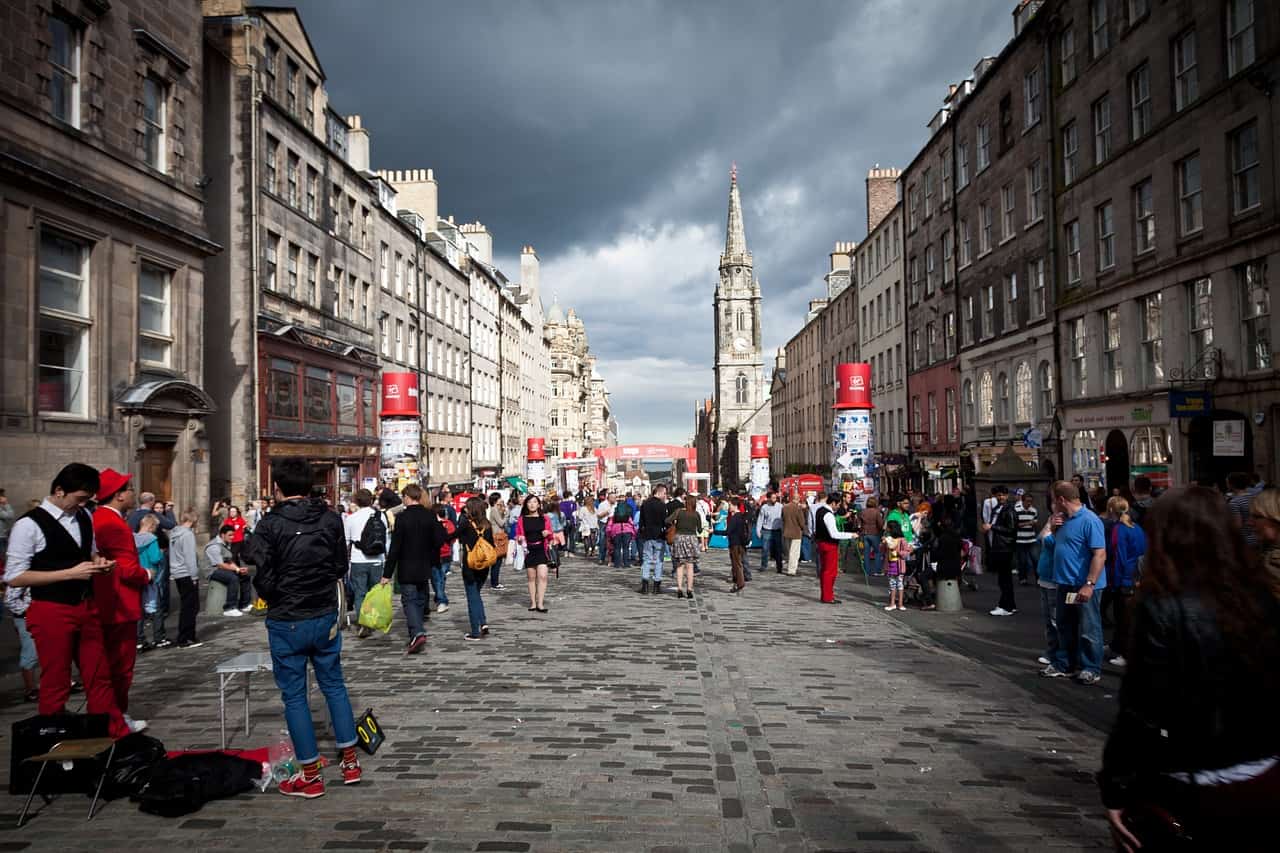
There aren’t many streets in the world that are tourist attractions in their own right, but Edinburgh’s Royal Mile easily takes the title on account of its fascinating mix of architecture and history.
Threading its way through the heart of the Old Town, the Royal Mile is a one-mile cobbled and paved road that links Edinburgh Castle at its top to Holyrood Palace at its bottom. Not only will you pass St. Giles Cathedral, Gladstones Land, and John Knox House as you meander up the sloping street, but you’ll also pass many locations that will give you a glimpse into Edinburgh’s past.
While walking the Royal Mile, keep an eye open for Makars Court, a quiet courtyard set back from the hustle and bustle of the main thoroughfare that is home to the Writers Museum. Inside the museum, you’ll find works from some of Scotland’s most famous writers, including Robert Burns and Robert Louis Stevenson.
I advise signing up for a guided tour with one of the guides who are typically waiting at the back of St. Giles Cathedral close to the Mercat Cross for the ultimate Royal Mile experience. These tours are reasonably priced and good fun, with each guide being an expert in the history of the murders and crimes that were part and parcel of the Old Town in years gone by.
The Royal Mile is also a good place to pick up a memento or two. If you want to purchase genuine Harris Tweed gifts, Scottish-brewed beer, or a bottle of premium Scotch whisky, The Royal Mile will have something to offer you.
The Water of Leith
Address: Visitor Centre, 24 Lanark Rd., Edinburgh, EH14 1TQ
Contact details: NA
Out About Scotland guide: The Water of Leith
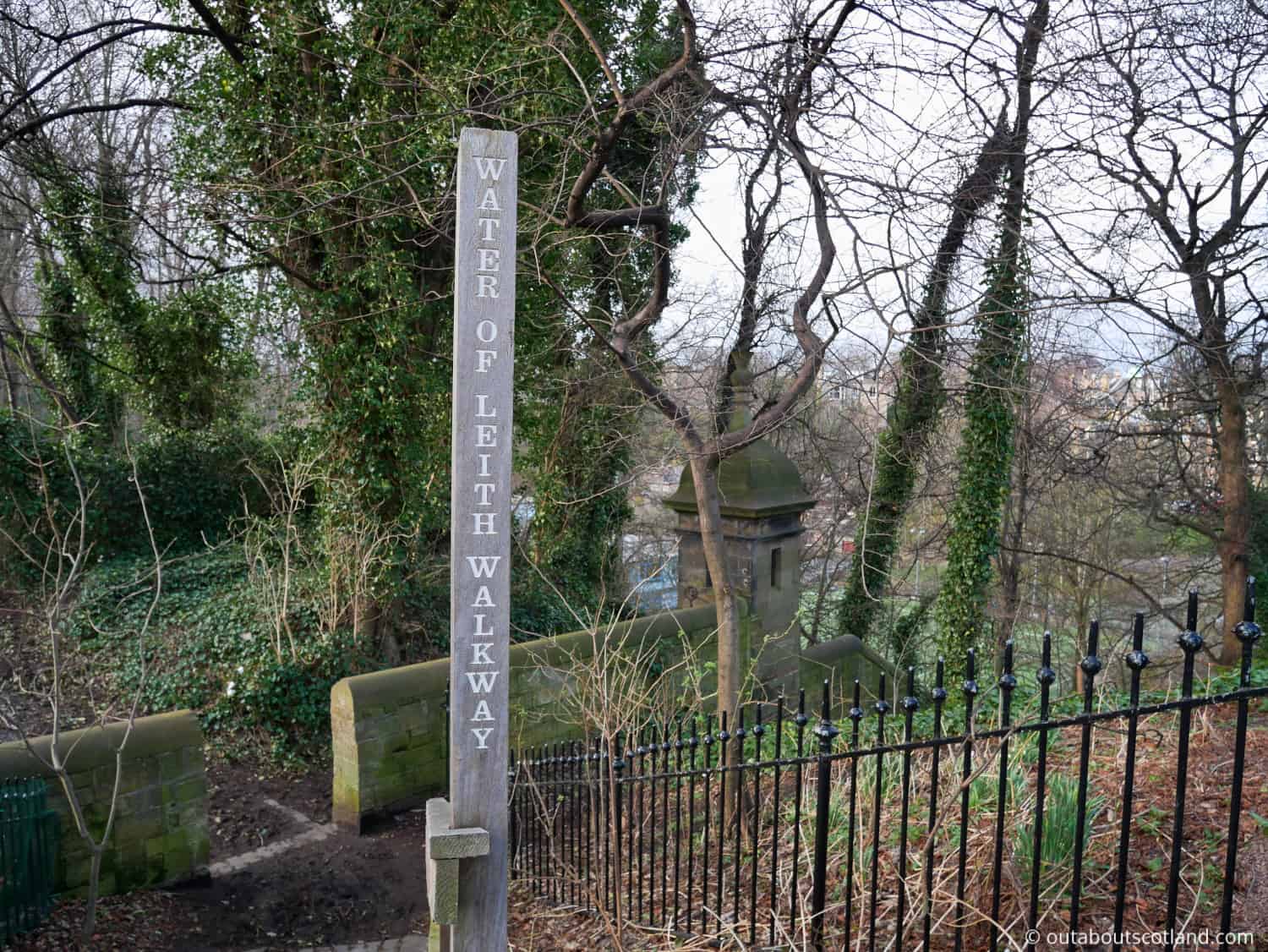
The Water of Leith winds 22 miles from the Colzium Springs in the Pentland Hills through the centre of Edinburgh to its final destination at Leith.
Visitors to Edinburgh might not be aware of the river but if you have a few days to explore the city you’ll be well-rewarded by a walk on the miles of quiet pathways that run alongside it. One of the most popular entry points is in Stockbridge – well-known amongst Edinburgh locals for its artisan gift shops and bistros – where there are several signposted paths that lead onto the riverside.
The Water of Leith walkway extends for 12 miles so if you want to do the entire route you might consider hiring a bike, although walking on foot is probably the best way to enjoy it as there are several sections that are interrupted by steps and gates.
Other popular entry points are Dean Village, where you can see the remains of Edinburgh’s watermills, and Bonnington, which is another interesting place to see the city’s industrial heritage.
A good way to plan your journey is to pick up a Water of Leith route map from any of the tourist information centres in the city. Alternatively, visitors can download an audio guide from the Water of Leith Conservation Trust website, which plays information about the river at waymarked points along the walkway.
The Best Tours in Edinburgh
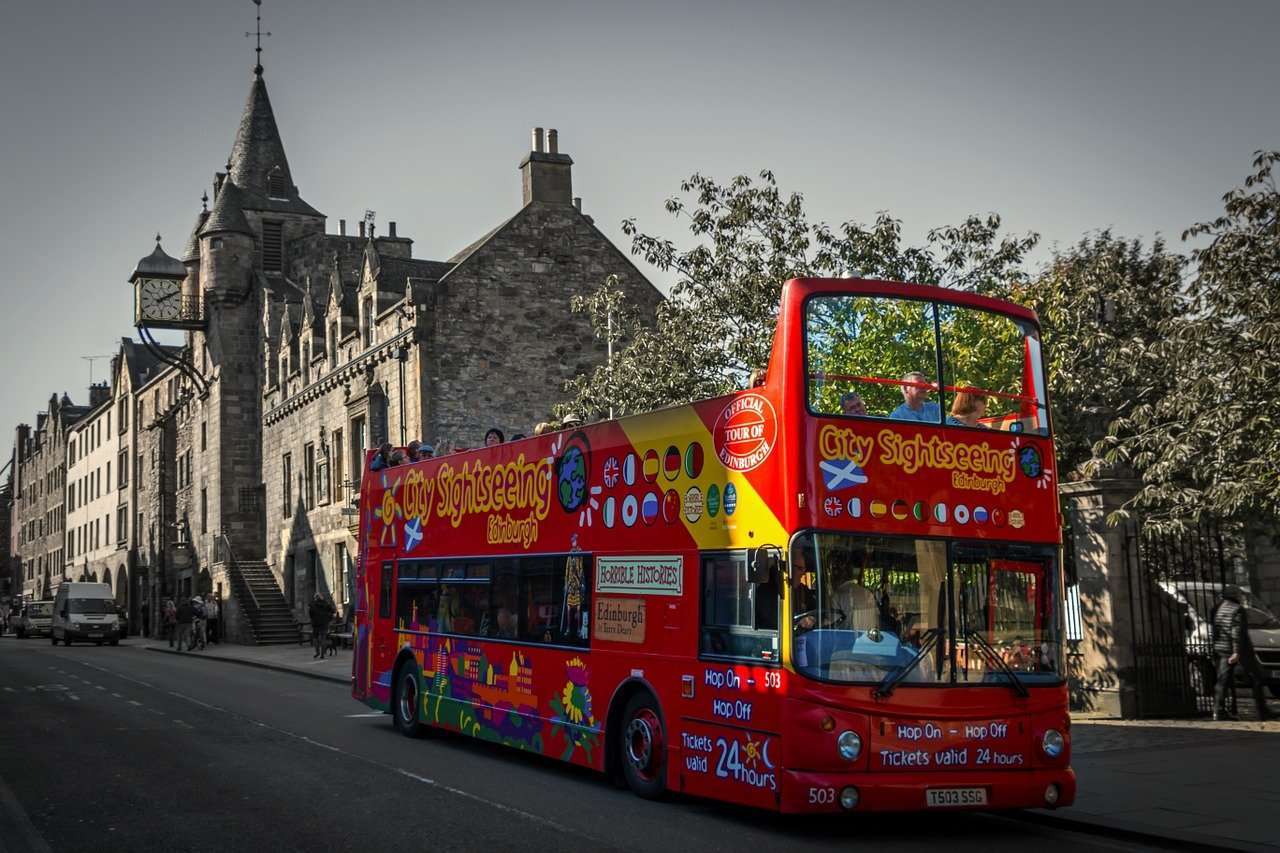
Edinburgh is a wonderful place, but sometimes it’s easiest to let someone else deal with planning a visit, and that’s where joining an organised tour comes into its own.
In Edinburgh, visitors can enjoy tours that focus on the best places to sample a dram of whisky, the places where JK Rowling drew inspiration for Harry Potter, the secret underground vaults, and Edinburgh’s most haunted sites. That being said, not everyone likes being part of a tour group, which is why another option for touring the city—the hop-on, hop-off tour bus—is one of the most popular ways for visitors to see Edinburgh.
The following list features a selection of the best-reviewed daily tours, along with self-guided tours that include pre-paid attraction tickets.
Harry Potter Guided Walking Tour.
There must be a lot of Potterheads out there because this guided walking tour is one of the highest-rated in Scotland on the Get Your Guide website. The tour will take you around the city to discover the secrets of Harry Potter, from the location of Tom Riddle’s tomb to the café where JK Rowling created the first in the series of famous books.
Book Now
Edinburgh Underground Vaults Tour.
Having done this tour myself, I can happily vouch that it’s a great way to see parts of the city that are otherwise off-limits to tourists. The vaults beneath Edinburgh’s streets date back hundreds of years, and this spooky tour takes you deep underground to hear ghostly tales about witches, murders, and the people who spent their entire lives in the gloomiest recesses of Edinburgh’s Old Town.
Book Now
Edinburgh Ghost Bus Tour.
For something a wee bit different, the Edinburgh Necrobus will take you to all the spookiest parts of the city with a tour guide that will tell you about the nefarious crimes of Burke and Hare, the plague victims that fill the graveyards, and the places where ghosts still roam the streets to this day.
Book Now
The Firth of Forth Boat Tour.
Visiting Edinburgh doesn’t just mean walking around the castle, as this boat tour along the Firth of Forth demonstrates. The 90-minute sightseeing cruise starts off in South Queensferry and visits the UNESCO World Heritage Forth Rail Bridge as well as Inchcolm Island and its atmospheric mediaeval abbey.
Book Now
Royal Attractions Ticket with Hop-On Hop-Off Bus Tour.
In my opinion, this is the best way for first-time visitors to see Edinburgh. Purchasing a ticket means you get unlimited use of an open-top tour bus that continually drives between all the main tourist hotspots, so you can visit each one at your leisure over two days.
The pass includes free entry to Edinburgh Castle, the Royal Yacht Britannia, and Holyrood Palace, which are the three biggest tourist attractions in the city.
Book Now
History of Whisky and Whisky Tasting Tour.
A visit to Edinburgh isn’t complete without a deep dive into the history and folklore of Scotland’s most prized export. On this tour, you’ll learn everything you ever wanted to know about ‘the water of life’ at a highly-rated whisky venue where you’ll sample four classic single malts.
Book Now
Resources
- For a list of suggestions for things to do in Edinburgh for couples, visit this page: 8 Best Attractions in Edinburgh for Couples.
- Looking for things to do in Edinburgh for families? You’ll find a collection of top attractions here: The Best Family Attractions in Edinburgh.
- Find a complete list of things to do in Edinburgh for young adults on this page: Best Attractions in Edinburgh.
Frequently Asked Questions
Where is Edinburgh?
Edinburgh is located in southeast Scotland, south of the Firth of Forth estuary, west of East Lothian, east of West Lothian, and north of Midlothian. Edinburgh is Scotland’s capital city and is one of 32 council areas in the country. It is Scotland’s second-most-populous city and the seventh-most populous city in the United Kingdom.
Why is Edinburgh famous?
Edinburgh is best known for its fabulous attractions that can be found throughout the city centre. The most famous of these is Edinburgh Castle, which is Scotland’s most-visited tourist attraction, regularly drawing over 2 million visitors each year.
Other top-rated Scottish attractions include Holyrood Palace, the National Museum of Scotland, the National Gallery of Scotland, Holyrood Park, and the Royal Mile.
When did Edinburgh become a city?
Edinburgh has existed for over 1,000 years, and it was originally a settlement centred around Castle Rock that was occupied by the Votadini tribe. Because the fort on Castle Rock was so simple to defend, it eventually became a royal palace, and in 1633, Edinburgh received full city status by royal decree.
Why is the city called ‘Edinburgh’?
The name Edinburgh is thought to originate from the occupation of Castle Rock by King Edwin of Northumbria in the 7th century. In Old English, burgh means fort, and it is believed the name given to the castle, ‘Edwin’s burgh’, transitioned over time into ‘Edinburgh’.





